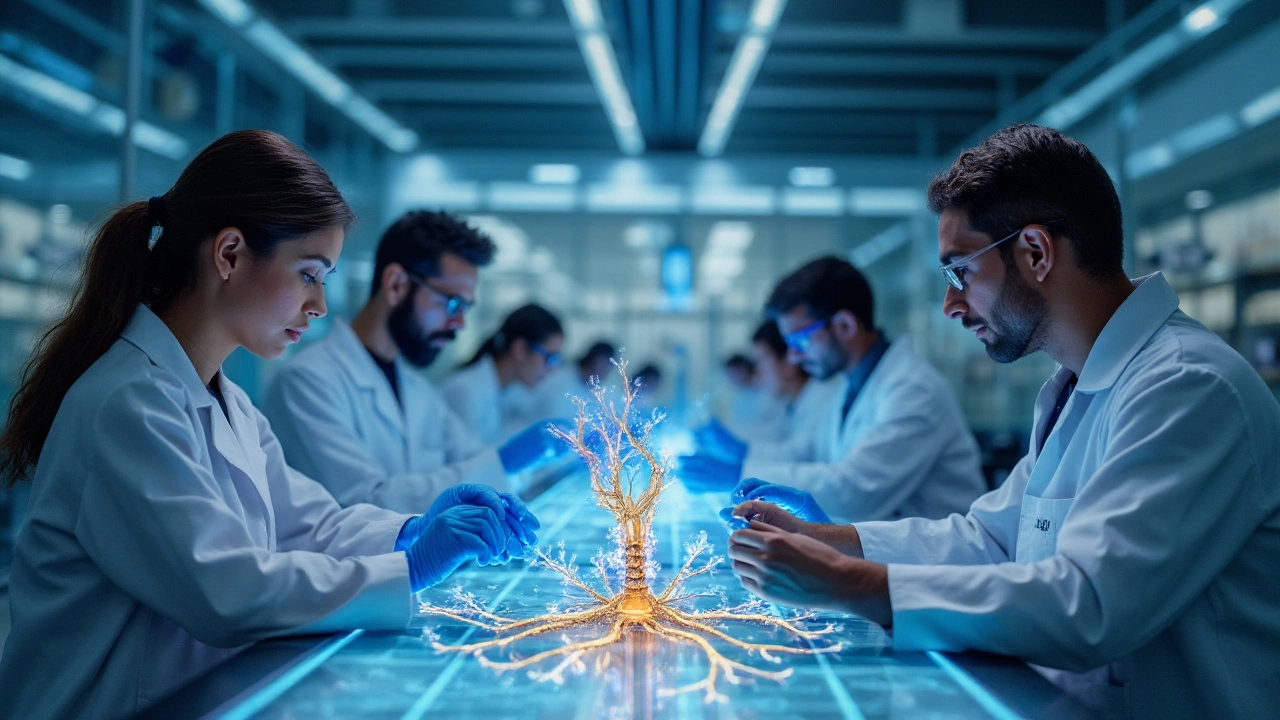Experiencing nerve damage can feel overwhelming, especially when uncertain about recovery possibilities. Yet, advancements in medical science continually provide hope for those affected. Whether the nerve injury is due to trauma, infection, or a chronic health condition, understanding the root cause plays a vital role in determining potential healing paths.
Nerve repair is not solely reliant on medical treatments. Incorporating certain lifestyle changes and therapies can aid the healing process. From physical therapy to nutritional adjustments, the scope of rehabilitation extends beyond the confines of surgical rooms and medicinal prescriptions. Step into the world where orthopedics intertwine with neurology, and uncover the layers of care available for nerve recovery.
- Types and Causes of Nerve Damage
- Current Treatment Options
- Supporting Nerve Healing
- Future of Nerve Repair
Types and Causes of Nerve Damage
Nerve damage comes in various forms, primarily categorized into three types: sensory, motor, and autonomic. Each type affects different functions, leading to diverse symptoms and challenges for individuals. Sensory nerves control sensation, and their damage can result in tingling, pain, or numbness, often described as a burning or stabbing feeling. Motor nerves influence muscle movements, so damage here could lead to weakness or paralysis. Autonomic nerve damage messes with involuntary body functions like blood pressure and digestion, causing broader health issues.
When we talk about causes, the list is long and varied. Physical trauma is one of the most direct causes of nerve injury. Whether from a fall or an accident, such injuries can break or compress nerves. Infections like Lyme disease or HIV can also lead to nerve issues. Systemic diseases, including diabetes, are notorious for causing neuropathy due to high blood sugar levels damaging small blood vessels that nourish nerves. One lesser-known cause includes cancer and the treatment associated with it, like chemotherapy, which can be toxic to nerves.
It's interesting to note that even lifestyle factors play a role in nerve health. Alcoholism, for instance, can lead to a condition called alcoholic neuropathy, where prolonged consumption damages nerves over time. Poor nutrition, notably deficiencies in vitamins like B12, can also cause nerve damage. In the realm of genetics, some individuals are predisposed to nerve damage due to inherited conditions like Charcot-Marie-Tooth disease, which impacts peripheral nerves.
Exploring these various causes is essential in understanding how nerve damage can be prevented and treated. Early intervention often hinges on identifying the root cause, underscoring the importance of a thorough medical history and diagnostic workup. As Dr. Susan McTavish, a neurologist at the NeuroHealth Clinic, once said,
"Often, the story of nerve damage begins long before the first symptoms appear. By addressing potential risk factors early, we might well change the ending."

Current Treatment Options
Dealing with nerve damage requires a multidisciplinary approach, heavily emphasizing personalized care. At the forefront of treatment are medications that manage symptoms like pain and inflammation. These can range from over-the-counter solutions such as anti-inflammatory drugs to more targeted options like gabapentinoids designed for neuropathic pain. For many patients, drugs are the first step toward restoring quality of life, offering relief from debilitating discomfort and paving the way for further therapeutic interventions.
In more severe cases, surgical interventions might be considered. Procedures such as nerve grafting or nerve decompression are common, depending on the damage type and its extent. Advanced surgical techniques have evolved, and today's orthopedic specialists can often repair nerves more precisely than in the past, thanks to modern technology. However, surgery is often a last resort, following the keen assessment of potential risks and benefits by healthcare professionals. Less invasive options are usually preferred unless absolutely necessary.
Rehabilitation plays a crucial role in the recovery process. Physical therapy, tailored to the individual's specific needs, helps maintain muscle strength and improve flexibility around the affected area. A combination of exercises focuses on enhancing blood flow and promoting the healing of nerves. Occupational therapy also contributes significantly, particularly if nerve damage affects daily activities. Therapists work with patients to develop strategies and tools that aid in performing everyday tasks efficiently, despite their limitations.
Emerging techniques in the field are promising as well. Stem cell therapy and biologics are gaining traction as potential treatment options. While still largely in the experimental stage, these therapies aim to regenerate damaged nerve tissues naturally, offering hope of fuller recovery without invasive procedures. Current studies are exploring their efficacy and safety, with researchers optimistic about their future role in nerve repair.
In the inspiring words of Dr. Jane Smith, a respected neurologist, "The synergy between traditional and cutting-edge methods in treating nerve damage heralds a new era of healing. We aim not merely for pain management but for complete recovery.”
Her research has shed light on the importance of integrating these emerging therapies sooner into standard care protocols to improve patient outcomes.
For patients navigating the challenging path of nerve regeneration, understanding the options available and collaborating closely with a medical team is key. This multifaceted approach ensures that treatments are both effective and tailored to individual needs. Whether exploring conventional methods or new alternatives, hope remains a constant companion in the journey towards recovery.

Supporting Nerve Healing
The journey to healing nerve damage often begins with a comprehensive approach, blending medical treatments with lifestyle changes that nurture the body's innate ability to repair itself. Nerve regeneration is a gradual process, and while it might require patience, the outcomes can be significantly rewarding. Key to supporting nerve recovery is ensuring that the entire bodily system is in optimal condition to encourage natural healing processes. That includes maintaining a balanced diet rich in essential nutrients like vitamins B12, B1, and E, which have been shown to play vital roles in nerve health.
Vitamins aren't the only allies in the quest for nerve damage repair. The inclusion of regular physical activity tailored to your condition can reduce inflammation and enhance blood circulation, which in turn supports nerve regeneration. Physical therapy exercises, prescribed by healthcare professionals, target specific nerve injuries and help maintain muscle strength and flexibility, preventing further deterioration. Hydration is also critical; water aids in transporting nutrients and removing toxins from the body, both crucial for healing.
Incorporating mind-body practices such as yoga, meditation, and mindfulness exercises can manage stress levels. High stress can negatively impact nerve repair, so finding effective ways to reduce it is crucial. Techniques like deep breathing exercises or guided imagery have been successful in promoting relaxation and improving the recovery environment.
"Stress is a leading impediment to healing, and addressing it holistically is integral," says Dr. Anthony Chaffee, a neurologist at the forefront of nerve repair research.
An often overlooked aspect of aiding nerve repair is ensuring adequate rest. Sleep is when your body does its most significant restorative work; during these hours, cells regenerate and damage repair occurs. Therefore, developing a healthy sleep routine—going to bed and waking up at the same time regularly, creating a restful environment, and limiting screen exposure before bedtime—can amplify the benefits of medical treatments and holistic approaches. Sleep research has continuously supported these findings, pointing to the complex relationship between sleep quality and nerve recovery.
For those seeking additional natural remedies, acupuncture and massage can be beneficial. Acupuncture has roots in traditional Chinese medicine and is believed to stimulate the nervous system, releasing chemicals in the muscles, spinal cord, and brain that enhance the body's healing mechanisms. Massage, on the other hand, helps to relieve tension, improve circulation, and reduce pain, all of which contribute to an environment conducive to healing nerves. It's crucial to consult with healthcare providers before starting any alternative treatment to ensure safety and compatibility with your specific condition.

Future of Nerve Repair
The horizon of nerve damage repair is as exciting as it is promising, driven by an intersection of neurology, biotechnology, and regenerative medicine. Emerging technologies are opening new doors, with research exploring revolutionary methods in improving orthopedics for nerve repair. Most noteworthy are advances in stem cell therapy, which holds potential to regenerate injured nerve tissues. Just imagine, harnessing the body’s own regenerative capabilities to mend what was once deemed irreparable.
Stem cells, often called the body's master cells, are being studied with the hope of rebuilding damaged nerves. They can transform into different cell types, opening vast possibilities in medicine. Researchers are experimenting with specific types, like Schwann cells, known for their role in nerve regeneration, thus offering new techniques to potentially mend nerve injuries. Dr. Smith, a leading neuroscientist, once stated,
"We are on the brink of redefining nerve repair, transcending traditional boundaries through cellular innovation". This underscores the optimism shared within the scientific community.
Beyond stem cells, gene therapy is another frontier with transformational potential. By targeting the genetic root of some nerve disorders, scientists are working on modifying genes to promote nerve health or slow degeneration. Currently, preclinical trials are being conducted to realize the dream of correcting genes that contribute to nerve damage. This goes to show how cutting-edge genetics offers both hope and complexity in the quest for comprehensive orthopedic solutions.
Bioengineered scaffolds are yet another significant development. Crafted from biodegradable materials, these structures support regeneration by providing a framework upon which new nerve cells can grow. Imagine a bridge that guides nerves to reconnect seamlessly. Coupled with growth factors and biochemical cues, these scaffolds are a beacon of future treatment options. Interestingly, these biomaterials are designed to degrade as they are replaced by new, healthy nerve tissue, thereby leaving no trace behind post-recovery.
Advancements are also being made in neuroprosthetics, which integrate electronic devices with the human nervous system to restore, substitute, or strengthen function. While initially aimed at assisting motion, these devices are now venturing into sensory restoration. Imagine a world where sensory feedback is restored to a prosthetic limb through nerve interfaces, providing a semblance of true touch. Such technological marriages between biology and devices stand to revolutionize rehabilitative care available at an orthopedic hospital.
